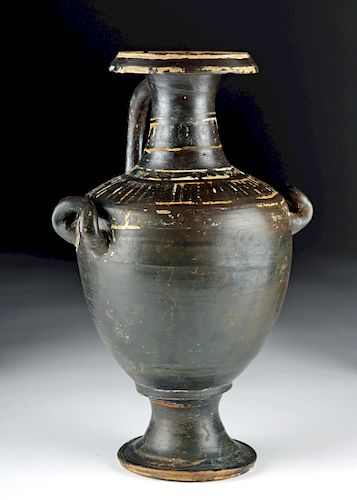Tall Greek Gnathian Blackware Hydria
Lot 19
About Seller
Artemis Fine Arts
686 S Taylor Ave, Ste 106
Louisville, CO 80027
United States
Selling antiquities, ancient and ethnographic art online since 1993, Artemis Gallery specializes in Classical Antiquities (Egyptian, Greek, Roman, Near Eastern), Asian, Pre-Columbian, African / Tribal / Oceanographic art. Our extensive inventory includes pottery, stone, metal, wood, glass and textil...Read more
Estimate:
$3,000 - $4,000
Absentee vs Live bid
Two ways to bid:
- Leave a max absentee bid and the platform will bid on your behalf up to your maximum bid during the live auction.
- Bid live during the auction and your bids will be submitted real-time to the auctioneer.
Bid Increments
| Price | Bid Increment |
|---|---|
| $0 | $25 |
| $300 | $50 |
| $1,000 | $100 |
| $2,000 | $250 |
| $5,000 | $500 |
| $10,000 | $1,000 |
| $20,000 | $2,500 |
| $50,000 | $5,000 |
| $100,000 | $10,000 |
| $200,000 | $20,000 |
About Auction
By Artemis Fine Arts
Feb 6, 2019
Set Reminder
2019-02-06 10:00:00
2019-02-06 10:00:00
America/New_York
Bidsquare
Bidsquare : Ancient | Ethnographic | Fine Art
https://www.bidsquare.com/auctions/artemis-gallery/ancient-ethnographic-fine-art-3848
Featuring classical antiquities, ancient and ethnographic art from cultures encompassing the globe. Artemis Fine Arts info@artemisgallery.com
Featuring classical antiquities, ancient and ethnographic art from cultures encompassing the globe. Artemis Fine Arts info@artemisgallery.com
- Lot Description
Magna Graecia, Southern Italy, near present-day Ignazia, ca. 340 to 320 BCE. A stunning and quite sizable blackware hydria, decorated in the Gnathian technique with fugitive white and yellow-orange pigment atop lustrous black glaze which has faded in some areas to reveal the orange pottery body beneath. The sloping shoulder is decorated with a band of enclosed vertical lines with one orange stripe for every two white stripes, and this register is further enclosed by two white-painted registers of undulating wave-form motifs. The neck displays a singular orange stripe beneath a register of drooping vine-form bands, and the rim is ringed above and below with yellow-white pigment. The hole through the bottom of the foot indicates that this piece was used to make liquid offerings when placed over the grave - an ancient Greek funerary practice. A wonderful example of Gnathian pottery, impressive for its elegant form and extensive decorative program. Size: 9.25" W x 14" H (23.5 cm x 35.6 cm).
Hydrias, as their name implies, were used for carrying large quantities of water; the two horizontal handles on either side of the body were used for lifting and transporting the por, while the third, vertical handle, located between the other two handles and joining neck to shoulder, was used when pouring water.
Gnathia ware is named for the site where it was first discovered - the Apulian site of Egnathia. The black glaze ware is traditionally decorated with floral motifs in red, white, or yellow hues. Scholars believe that its production was most likely centered around Taras, with primary workshops in Egnathia and Canosa. The quantity and quality of Greek colonial Apulian potters increased significantly following the Peloponnesian War when Attic exports dramatically decreased. Apulian artistry demonstrates influences of Ionian (Athenian, Attic) conventions, as well as Doric (western colonial Greek) styles, with a palpable native Italic aesthetic.
For a stylistically-similar example of a miniature size and with a tiered foot, please see The Metropolitan Museum of Art, accession number 41.162.224: https://www.metmuseum.org/art/collection/search/254395
Provenance: private East Coast, USA collection; ex-Gabriel Vandevort collection, Montrose, California, USA
All items legal to buy/sell under U.S. Statute covering cultural patrimony Code 2600, CHAPTER 14, and are guaranteed to be as described or your money back.
A Certificate of Authenticity will accompany all winning bids.
We ship worldwide and handle all shipping in-house for your convenience.
#140428Minor nicks and chips to rim, handles, body, and foot, with fading and chipping to most areas of pigmentation, lightening to some black-glazed areas, and some age-related fissures not indicative of repair, otherwise intact and excellent. Light earthen deposits and nice traces of pigmentation throughout. Nice craquelure and faint silver iridescence to some glazed areas.Condition
- Shipping Info
-
All shipping is handled in-house for your convenience. Your invoice from Artemis Gallery will include shipping calculation instructions. If in doubt, please inquire BEFORE bidding for estimated shipping costs for individual items.
-
- Buyer's Premium



 EUR
EUR CAD
CAD AUD
AUD GBP
GBP MXN
MXN HKD
HKD CNY
CNY MYR
MYR SEK
SEK SGD
SGD CHF
CHF THB
THB















